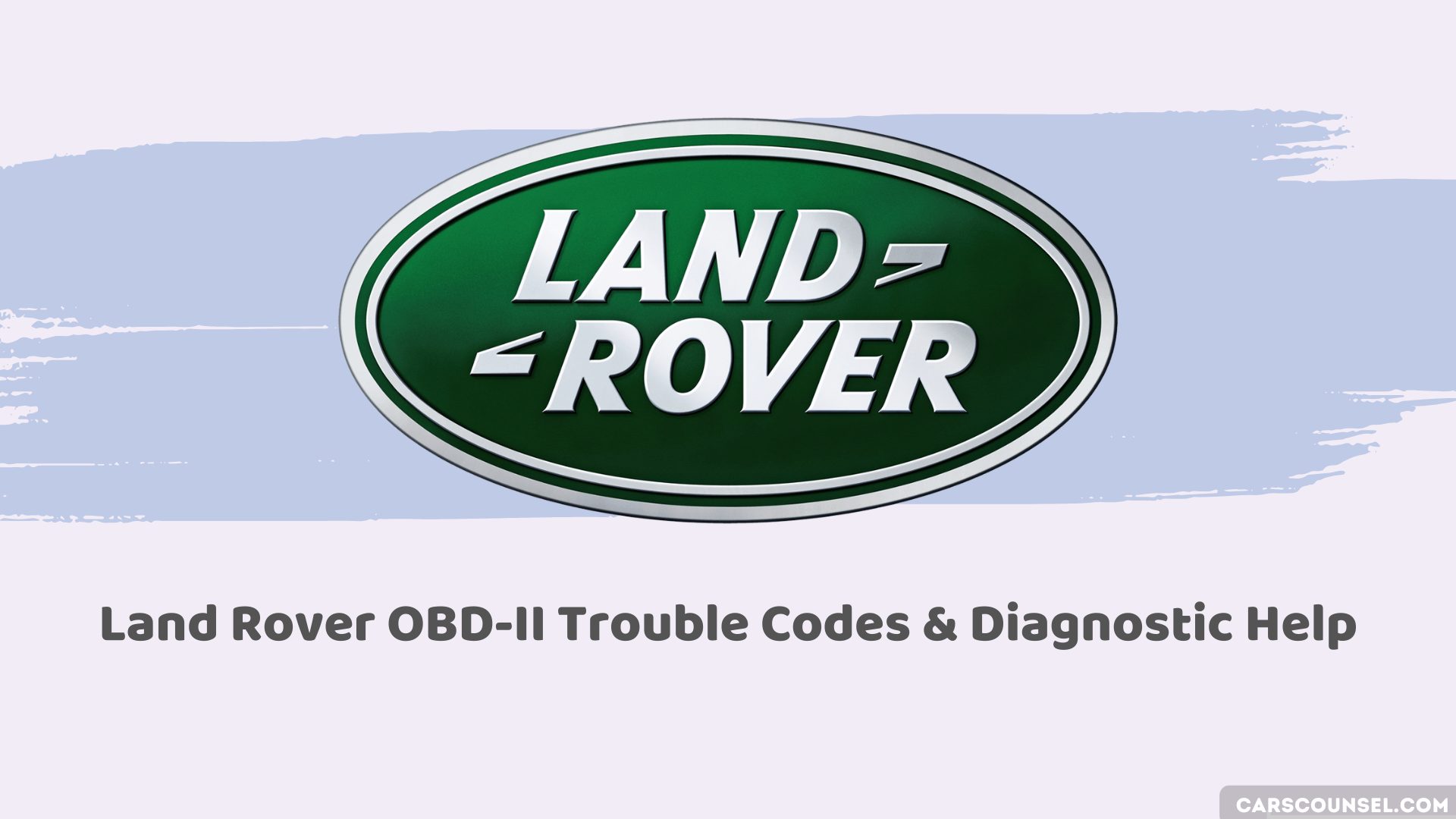As you turn the key in your Land Rover’s ignition, the engine roars to life, but the check engine light casts a shadow of uncertainty, like a storm cloud on the horizon. You know something’s amiss, but what? The cryptic code on your dashboard is just the tip of the iceberg, hiding a complex web of issues that only a skilled detective can unravel.
To uncover the truth, you’ll need to decipher the secrets of Land Rover’s OBD/OBD2 codes, which are written in a language that only the initiated can understand. Can you crack the fault code and get your vehicle back on track?

Quick Navigation
Understanding Land Rover Codes
When Land Rover OBD-II trouble codes appear, it’s essential to dig deeper to pinpoint the issue’s root cause.
You’ll need to understand that certain codes, starting with P1, are specific to Land Rover vehicles and require expert diagnosis.
The Generic Engine Management System (GEMS) used in Land Rovers monitors engine performance and detects faults, triggering the Malfunction Indicator Lamp (MIL).
GEMS Diagnostic Trouble Codes (DTC) can only be extracted, diagnosed, and cleared by specialized tools, such as the TestBook Diagnostic Unit.
As a Land Rover owner, it’s vital to have your vehicle diagnosed by a certified specialist with access to the latest diagnostic equipment and techniques.
This guarantees accurate diagnosis and repair of the control module and other engine systems.
Diagnosing OBD-II Issues
Beyond the dashboard warning lights, diagnosing OBD-II issues in your Land Rover requires a more thorough examination into the vehicle’s complex systems.
To access the vehicle’s unique protocol, you’ll need specialized tools, like the TestBook Diagnostic Unit. Land Rover fault codes are categorized into groups such as Airbag, Lighting, and Door systems.
When diagnosing OBD-II issues, consult the Land Rover TestBook Electronic Tester to extract, diagnose, and clear Diagnostic Trouble Codes (DTCs).
The Generic Engine Management System (GEMS) uses sensors, including the oxygen sensor, to monitor engine conditions and detect faults, triggering the Malfunction Indicator Lamp (MIL) on the instrument cluster.
Accurate diagnosis and repair are essential to guarantee proper engine performance.
Land Rover Diagnostic Tools
With your Land Rover’s complex systems, you’ll need the right diagnostic tools to identify and fix issues efficiently.
When dealing with Land Rover OBD-II Trouble, you can’t rely on generic tools that may not provide accurate readings or access to Rover-specific data.
- Land Rover Diagnostic Software: Utilize software specifically designed for Land Rover models, such as the Land Rover Discovery, to access detailed trouble code information and perform advanced diagnostics.
- OBD-II Code Readers: Invest in an OBD-II code reader that can retrieve and clear Land Rover-specific OBD-II Codes, ensuring you’re getting accurate information.
- Rover-Specific Scan Tools: Consider specialized scan tools that provide in-depth analysis and testing capabilities tailored to Land Rover systems, allowing for precise fault diagnosis and repair.
Most Common Land Rover OBD-II Trouble Codes
| Code | Description |
|---|---|
| B0001 | Driver’s frB0001ontal stage 1 – deployment control |
| B0002 | Driver’s frontal stage 2 – deployment control |
| B0004 | Driver’s knee bolster deployment control |
| B0005 | Collapsible steering column deployment control |
| B0010 | Passenger’s frontal stage 1 – deployment control |
| B0011 | Passenger’s frontal stage 2 – deployment control |
| B0020 | Left side air bag deployment control |
| B0021 | Left curtain deployment control 1 |
| B0022 | Left curtain deployment control 2 |
| B0028 | Right side air bag deployment contro |
| B0029 | Right curtain deployment control 1 |
| B002A | Right curtain deployment control 2 |
| B0050 | Driver’s safety belt sensor |
| B0052 | Passenger’s safety belt indicator |
| B00D2 | Restraint system malfunction indicator 1 |
| B00D5 | Restraint system passenger disable indicator |
| B00DF | Passenger restraints disable switch |
| B0155 | CAN instrument cluster node missing |
| B0300 | Network management expulsion |
| B1000 | Right hood hinge deployment control |
| B1001 | Right hood deployment control |
| B1002 | Left hood hinge deployment control |
| B1003 | Left hood deployment control |
| B1004 | Right frontal impact classification sensor |
| B1005 | Left frontal impact classification sensor |
| B1006 | Front center impact classification sensor |
| B1007 | High beam headlamps switch |
| B1008 | Windshield wiper mode switch |
| B1009 | Ignition authorisation |
| B100A | Fuel pump authorisation |
| P0101 | Air flow to throttle angle cross check fault |
| P0102 | Mass air flow sensor fault – Signal out of range – below minimum |
| P0103 | Mass air flow sensor fault – Signal out of range – above maximum |
| P0112 | Intake-air temperature sensor fault (in MAFS) – Signal out of range – below minimum |
| P0113 | Intake-air temperature sensor fault (in MAFS) – Signal out of range – above maximum |
| P0122 | Throttle Position Sensor Low Out of Range Fault |
| P0123 | Throttle Position Sensor High Out of Range Fault |
| P0125 | Engine Coolant Temp Sensor Warm Up Fault |
| P0130 | Oxygen Sensor Cycle Fault |
| P0131 | Oxygen Sensor Low Voltage |
| P0132 | Oxygen Sensor High Voltage |
| P0133 | Oxygen Sensor Slow Response |
| P0172 | Oxygen Sensor System Too Rich Fault Bank A |
| P0174 | Oxygen Sensor System Too Lean Fault Bank B |
| P0175 | Oxygen Sensor System Too Rich Fault Bank B |
| P0181 | Fuel Temperature Sensor Signal Error Fault |
| P0182 | Fuel Temperature Sensor Low Out of Range Fault |
| P0183 | Fuel Temperature Sensor High Out of Range Fault |
| P0201 | Injector 1 Circuit Fault |
| P0202 | Fuel Injector fault – cylinder 2 |
| P0203 | Fuel Injector fault – cylinder 3 |
| P0204 | Fuel Injector fault – cylinder 4 |
| P0205 | Fuel Injector fault – cylinder 5 |
| P0206 | Fuel Injector fault – cylinder 6 |
| P0207 | Fuel Injector fault – cylinder 7 |
| P0208 | Fuel Injector fault – cylinder 8 |
| P0300 | Misfire On Multiple Cylinder |
| P0301 | Misfire Cylinder 1 |
| P0302 | Misfire Cylinder 2 |
| P0303 | Misfire Cylinder 3 |
| P0304 | Misfire Cylinder 4 |
| P0305 | Misfire Cylinder 5 |
| P0306 | Misfire Cylinder 6 |
| P0307 | Misfire Cylinder 7 |
| P0308 | Misfire Cylinder |
| P0326 | Continuous Knock Fault Bank A |
| P0327 | Background Noise Low Fault Bank A |
| P0328 | Background Noise High Fault Bank A |
| P0721 | Downshift safety monitoring |
| P0722 | Stall speed monitoring |
| P0731 | Gear ratio monitoring (1st gear) |
| P0733 | Gear ratio |


Nice piece of info
Thanks